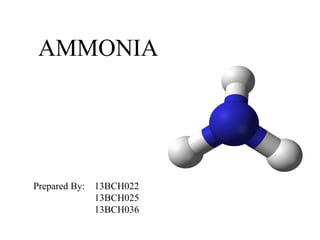
Ammonia
- 2. Introduction • Ammonia received its official name as "ammoniac" in 1787 from the Latin name of “ammonium chloride - sal ammoniac”; because that salt was obtained near the temple of Egyptian god Amon. • ammonia was first isolated by Joseph Priestley in 1774 and was termed by him "alkaline-air". Eleven years later in 1785, Claude Louis Berthollet ascertained its composition. • The Haber–Bosch process to produce ammonia from the nitrogen in the air was developed by Fritz Haber and Carl Bosch in 1909 and patented in 1910. • It was first used on an industrial scale in Germany during World War I. The ammonia was used to produce explosives to sustain war efforts.
- 3. Properties of Ammonia • Molecular weight : 17 gm/mol • Boiling point : -33.34 ˚C • Freezing point : -77.7 ˚C • Standard heat of formation: -46 222 KJ/Kmol • Solubility : Soluble In chloroform, ether, ethanol • Density : 0.769 Kg/𝑚3 At STP
- 4. Uses of Ammonia Refrigerant Industry Preservative Transport of 𝐻2 Metal treatment Lab reagent Solvent Medicine & Cosmetics
- 5. Uses of Ammonia In Industries Fertilizer Industry Petroleum Industry Mining Industry Rubber Industry Paper Industry Leather Industry
- 6. MANUFACTURING PROCESSES • The synthesis gas for manufacture of Ammonia is produced by steam reforming or partial oxidation of Hydrocarbon feed. • The various processes used commercially in industries for production of Ammonia are : 1. Imperial chemical Industries (ICI) 2. Haber–Bosch Process 3. Braun Purifier Process
- 7. 1. Imperial chemical Industries (ICI) • Hydrocarbon feed is subjected to steam reforming in two stages to form oxides of Carbon, methane and hydrogen. • In the secondary reformer air is mixed with the gases to get a N2 : H2 ratio of 1:3. • Carbon monoxide is removed by shift conversion. Carbon dioxide is removed by absorption into or Potassium Carbonate solution. • Traces of CO and CO2 are removed by conversion into methane. Synthesis gas is used to produce ammonia.
- 8. Advantages of ICI Process • Intensive heat recovery • Generation of steam which can be imported. • Less dependency on electricity • Capital cost is least.
- 9. 2. Haber – Bosch Process • The Haber–Bosch process, is the industrial implementation of the reaction of nitrogen gas and hydrogen gas. It is the main industrial procedure to produce ammonia: N2 + 3 H2 → 2 NH3 (ΔH = −92.4 kJ·mol−1)
- 10. A Flow Scheme of Haber Process
- 12. Parameters • Temperature: 450˚C, moderately high. Using a lower temperature would increase yield at equilibrium, but the reactions would be too slow. The temperature is a compromise between rate and position of equilibrium. • Pressure: 200-1000 atm. Pressure is beneficial in terms of rate and position of equilibrium, so a very high pressure is used. The pressure is not even higher as the cost of maintaining it is more than the value of the extra ammonia that would be made. • Catalyst: Iron, As the rates are increased, the temperature used need not be so high as that which would be required in the absence of a catalyst. By allowing a lower temperature to be used, the position of equilibrium is more favourable as the Haber process is exothermic in the forward direction.
- 13. Major Engineering Problems • Reaction kinetics and equilibrium : • As per Le Chatelier principle for exothermic reaction lower temp favour the forward reaction and for decreasing moles the higher pressure is favourable. • From graph (1) & (2) the equilibrium yield of NH3 is increased by increase in pressure and decrease in temperature.
- 14. • Catalyst : • All catalyst based on FeO. Nowadays promoters like oxides of Al, Zr, K are added to make the catalyst more porous and to withstand the high temperature.
- 15. • Space velocity : • It is the volume of gases at standard condition that passed over the catalyst bed per unit time with increase in space velocity. • The % NH3 will decrease most industries uses space velocity of 10000-20000 per hour.
- 16. 3. Braun Purifier Process • In this process Synthetic ammonia (NH3) refers to ammonia that has been synthesized from natural gas. Natural gas molecules are reduced to carbon and hydrogen. The hydrogen is then purified and reacted with nitrogen to produce ammonia.
- 20. • The first stage is purification where impurities, mainly sulphur compounds, are removed from the gas stream. • Steam reforming is performed in two stages. In the primary stage, the endothermic reactions take place at pressures around 30 bar and temperatures of 800°C or higher. This is followed by an exothermic secondary reformer where air is added to the partially reformed gas stream. • The carbon monoxide in the gas leaving the secondary reformer is converted to carbon dioxide in the shift reactors and then removed by scrubbing from the gas stream. Any residual carbon oxides are then converted back to methane by methanation before compression of the hydrogen and nitrogen to ammonia synthesis pressure. • The final reaction stage is ammonia synthesis where the hydrogen and nitrogen combine to form ammonia. This reaction stage takes place at high pressure (100-350 bar) and is highly exothermic.
- 21. Ammonia Industries in India • Indian Farmers Fertilizer Cooperative Ltd. • Gujarat State Fertilizers Cooperative Ltd. • Deepak Fertilizers & Petrochemicals Cooperative Ltd. • Southern Petrochemical Industries Cooperative Ltd. • Zuari Agro Chemicals Ltd.
- 22. Reactor for Ammonia Synthesis